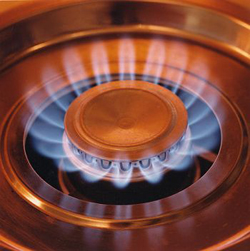[OPINION] Over the Cliff for Natural Gas in North America?
http://scitizen.com/stories/Future-E...
Is natural gas production in North America headed for cliff? No one can know for sure; but all signs point down.
The recent crash in North American natural gas prices has been welcome news for industrial, commercial and residential gas consumers. The reason behind the decline in prices, however, is not so welcome, namely, an economy fallen into a deep and still developing recession, one that some believe will ultimately fit the frightening, but rather vague definition of an economic depression.
But there is reason for North American natural gas consumers to fear the bargain basement prices they are now getting. For the time being, demand is plummeting while supply remains more than ample. New supply is still streaming in due to increased drilling activity in the wake of the fantastic runup in natural gas prices last year to around $14 per thousand cubic feet. But today's low price of around $4.75 is causing drillers increasingly to lay down their drills and await higher prices. Just last year at this time combined natural gas rig counts for Canada and the United States were 1,753 for the week ending January 18, 2008. Today, the comparable count is 1,472, a decline of 16 percent.
We can expect more declines in rig count as long as the low prices persist since many of the largest drillers have already announced plans to reduce drilling sharply this year. In addition, since natural gas is often found in association with oil, the decline in oil drilling will affect natural gas supplies to a certain degree.
Perhaps of most concern is that yearly decline rates for existing natural gas wells are now running at an aggregate 30 percent for North America. That means that if all drilling ceased for natural gas, production in a year would be down to 70 percent of today's total. Production would decline below 25 percent of today's level if this moratorium went on for four years.
The upshot is that North America is on a natural gas treadmill and must drill furiously just to stay even. There are several problems, however, that complicate this effort. First, the decline rates appear to be increasing. Natural gas wells drilled in the large shale basins of the United States which have been the major source of new gas in recent years exhibit exceedingly high decline rates, many wells declining 65 percent in the first year. The flows decline by less in the following years, but often by the fourth year the wells are not economical to operate. Second, the high and increasing decline rates imply a need for exponential growth in the number of new wells required to replace losses from existing wells and provide for growth in supply besides. The need for that kind of growth in new wells will also increasingly put upward pressure on the demand for rigs and the personnel to run them.
Third, the energy return on investment or EROI is declining for new sources of natural gas. That means, of course, that it is taking much more energy to get the new, mostly unconventional gas out of the ground. The implication is that much of the new unconventional gas resource won't be worth extracting. Fourth, and perhaps most worrisome, is the possibility of a rapid decline from conventional wells that still make up the majority of production in North America.
Petroleum geologist Jean Laherrère has estimated that a cliff in conventional natural gas production awaits North America in the next two to three years as declines in conventional production begin to mirror the prior bust in conventional gas discovery with approximately a 23-year lag.In addition, liquified natural gas (LNG) imports are not likely to increase much in the next few years since
LNG projects are now being delayed for myriad reasons including low natural gas prices, lack of credit, and limited supplies of natural gas for liquefaction facilities. Just when the North American continent may need LNG imports the most, there simply won't be enough LNG regasification capacity on the North American continent to make a decisive difference.
There is one certain and effective response to the risks to North American natural gas supply: conservation. But neither the Canadian nor the U. S. government seems to believe there is a problem. This is the case despite a decade of high natural gas prices and huge price swings that have ultimately sent many industries dependent on natural gas overseas for cheaper and more reliable supplies. Even today, after one of the biggest declines in natural gas prices in history, the North American natural gas price remains some 140 percent above where it was early in this decade.
Until now the ideology of administrations on both sides of the U.S.-Canadian border has led to an almost entirely free-market approach to natural gas supplies. With a new administration installed in Washington recently that may change. But the change may not come soon enough to save North America from a natural gas cliff.


